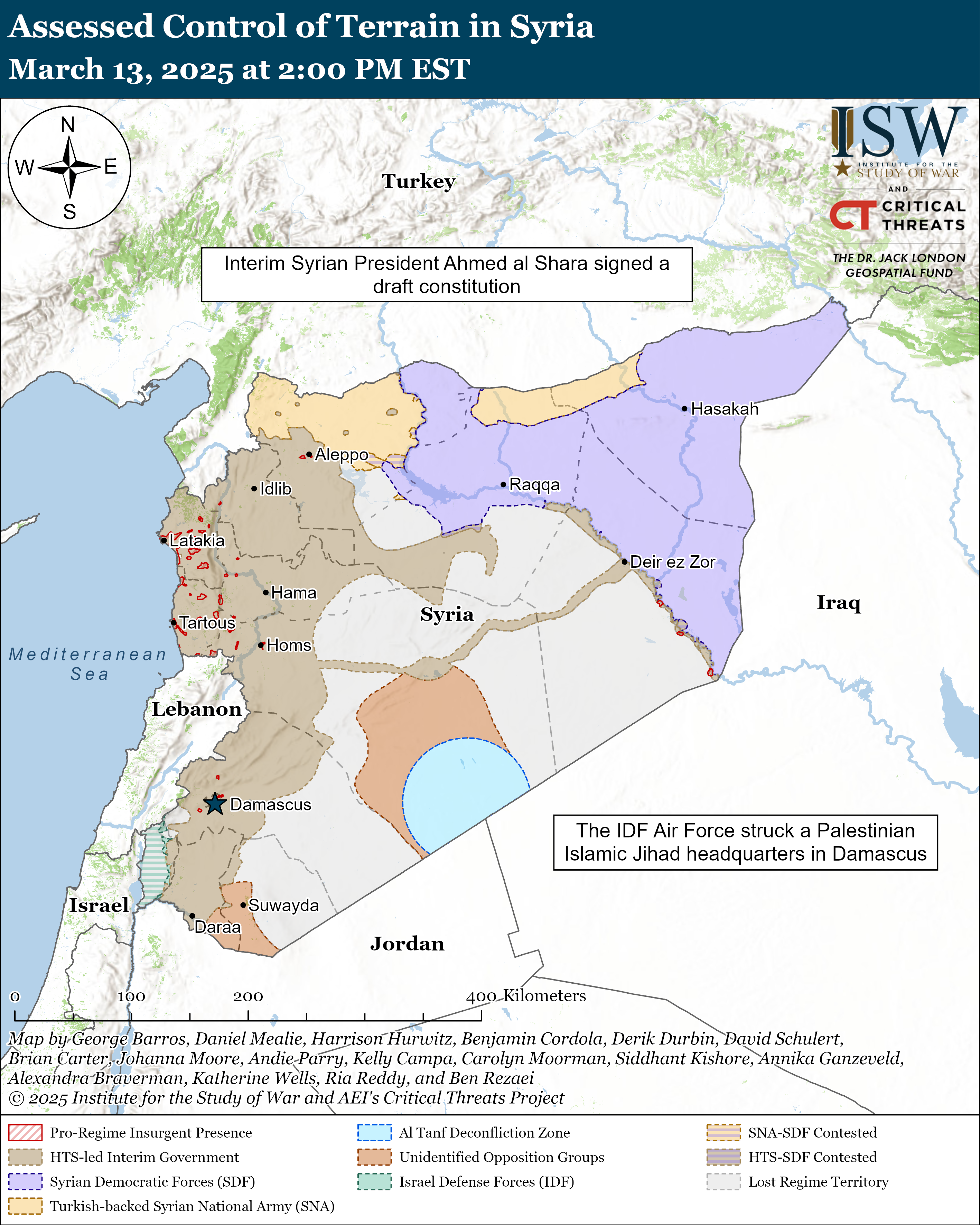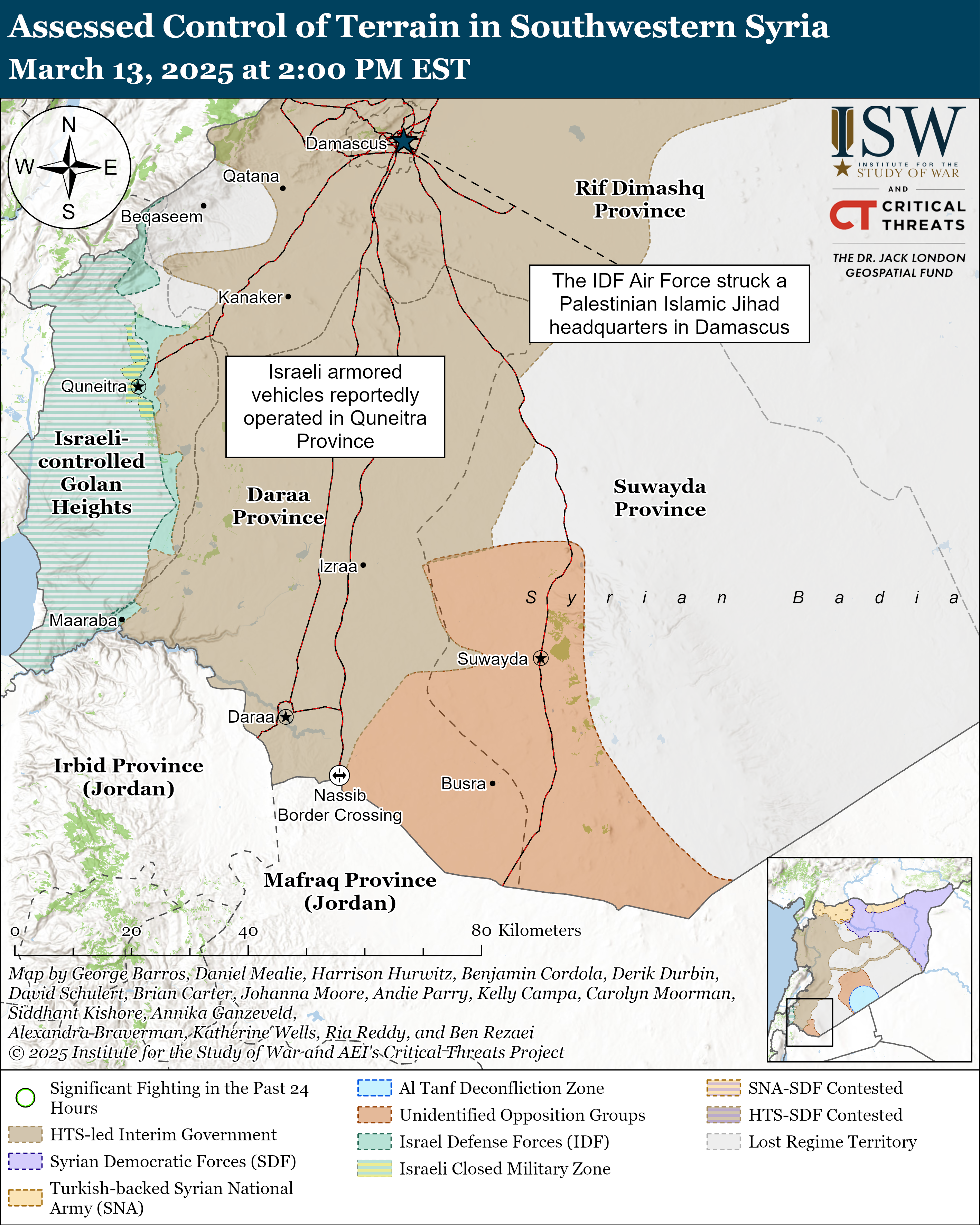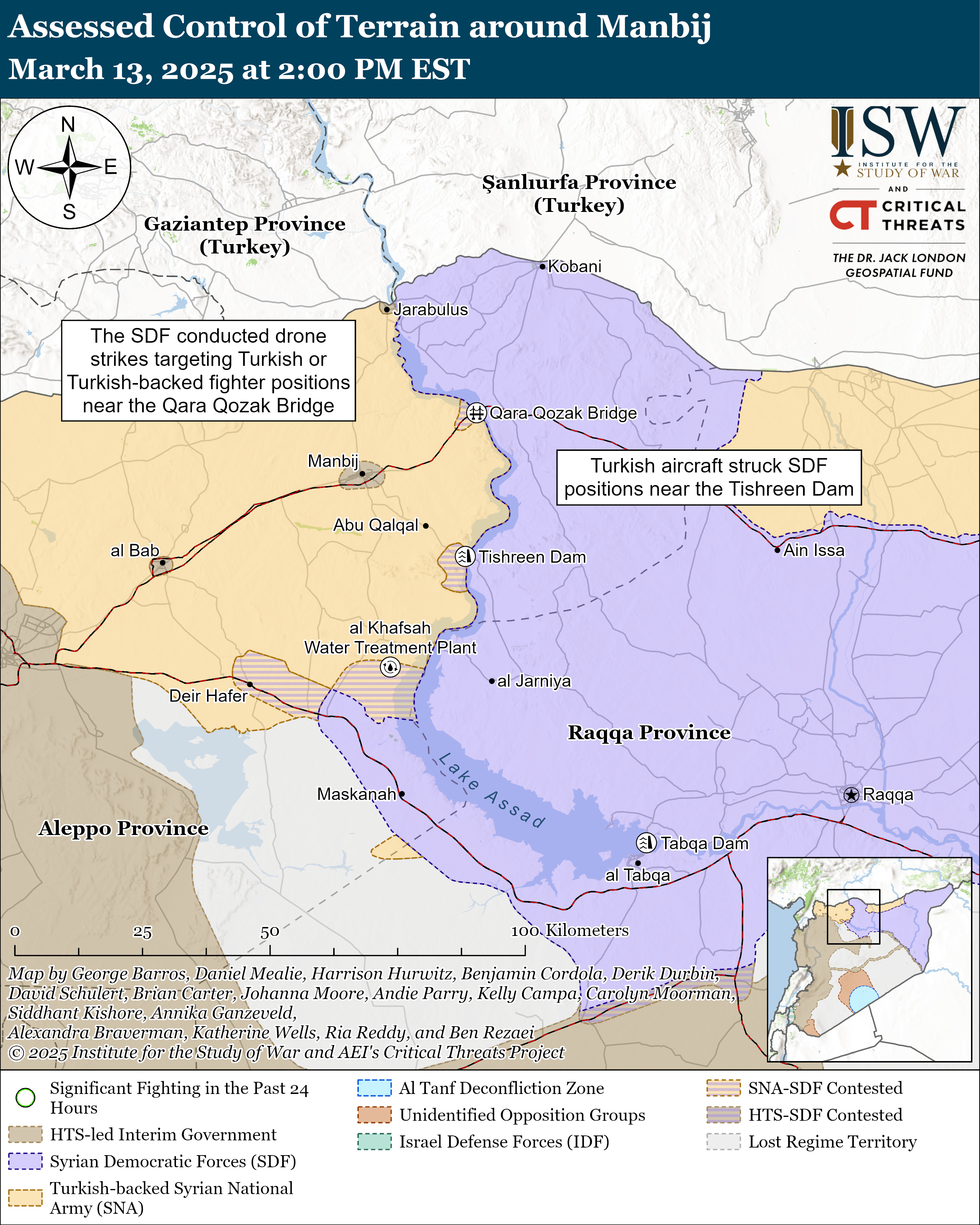Andie
Parry, Katherine Wells, Carolyn Moorman, Alexandra Braverman, Ria
Reddy, Siddhant Kishore, Alexis Thomas, Annika Ganzeveld, and Nicholas
Carl
Information Cutoff: 2:00 pm ET
The
Critical Threats Project (CTP) at the American Enterprise Institute and
the Institute for the Study of War (ISW) publish the Iran Update, which
provides insights into Iranian and Iranian-sponsored activities that
undermine regional stability and threaten US forces and interests.
CTP-ISW publishes the Iran Update every weekday.
Click here to see CTP and ISW’s interactive map of Israeli ground operations, and here
to see CTP and ISW’s interactive map of the ongoing opposition
offensive in Syria. These maps are updated daily alongside the static
maps present in this report.
We do not report in
detail on war crimes because these activities are well-covered in
Western media and do not directly affect the military operations we are
assessing and forecasting. We utterly condemn violations of the laws of
armed conflict and the Geneva Conventions and crimes against humanity
even though we do not describe them in these reports.
The
Houthis have sought to obtain hydrogen fuel cells from unspecified
Chinese suppliers to increase the range and payloads of their drones,
according to a November 2024 Conflict Armament Research (CAR)
investigation.[1]
CAR reported that the Yemeni National Resistance Forces seized hydrogen
cylinders bound for the Houthis in August 2024 that the Houthis
intended to use for drone production.[2]
CAR reported that the range of hydrogen-powered drones is at least
three times greater than other drones. The Houthis conducted frequent
drone attacks against Israel during the October 7 War and could use
hydrogen-powered drones to attack Israel, commercial shipping, and US
interests in the region. The Houthis announced on March 11 the
resumption of their attack campaign on international shipping.[3]
Interim Syrian President Ahmed al Shara signed a draft constitution on March 13 that initiates a five-year transition period.[4] The
Constitutional Committee emphasized that the document ensures a
separation of powers between the legislative, executive, and judicial
branches.[5] The document is based on Islamic jurisprudence but protects religious freedoms.[6] The constitution also grants Syrian women rights to education, employment, and political participation.[7] The constitution enshrines the freedoms of opinion, expression, information, publication and the press.[8]
The constitution reflects the topics that Syrians discussed at the
National Dialogue Conference in late February 2025, including
transitional justice, personal liberties, the role of civil society, and
economic principles.[9]
The principles enshrined in the constitution are encouraging and may
alleviate Western concerns that Shara’s Salafi-jihadi roots will
negatively impact ethnic, gender, and religious protections.
Shara could use some of the articles in the constitution to consolidate his power over the Syrian state. Shara
will appoint a third of the Syrian legislature, called the People’s
Assembly. Shara could appoint individuals who are loyal to him and
reluctant to hold him accountable.[10]
Shara will also select the committee that will appoint the other
two-thirds of the legislature, giving him further influence over the
body’s composition.[11]
Shara will appoint all seven members of the Supreme Constitutional
Court, which gives him influence over how the court interprets the law.[12]
The constitution grants Shara the right to declare a state of emergency
with the approval of the National Security Council for a maximum period
of three months.[13]
The newly-formed National Security Council is comprised of Shara
loyalists, including Defense Minister Murhaf Abu Qasra, Interior
Minister Ali Keddah, Foreign Minister Asaad al Shaibani, and
Intelligence Director Anas Khattab.[14]
It is unclear under what conditions Shara could declare a state of
emergency and what special authorities he would assume during a state of
emergency.
Key Takeaways:
- Houthi Military Capabilities: The
Houthis have sought to obtain hydrogen fuel cells from unspecified
Chinese suppliers to increase the range and payloads of their drones,
according to a Conflict Armament Research (CAR) investigation. CAR
reported that the range of hydrogen-powered drones is at least three
times greater than other drones. The Houthis conducted frequent drone
attacks against Israel during the October 7 War and could use
hydrogen-powered drones to attack Israel, commercial shipping, and US
interests in the region.
Syrian Constitution: Interim
Syrian President Ahmed al Shara signed a draft constitution on March 13
that initiates a five-year transition period. The Constitutional
Committee emphasized that the document ensures a separation of powers
between the legislative, executive, and judicial branches. The
constitution enshrines the freedoms of opinion, expression, information,
publication and the press. Shara could use some of the articles in the
constitution to consolidate his power over the Syrian state, however.
Syria

Former
Assad regime members have continued to attack Syrian interim government
forces in Latakia Province since CTP-ISW's last data cutoff on March
12. Former Assad regime members attacked the gate of military barracks near Beit Yashout, Jableh District, on March 12.[15] Interim government forces arrested four perpetrators.[16]
Interim government forces disabled an improvised explosive device (IED)
planted by former regime members along the Latakia-Jableh highway.[17] Syrian media noted that this incident marked the first time that former regime members used an IED.[18] Interim government forces separately seized weapons and ammunition near Salata in the Qardaha countryside.[19]
A
Syrian reporter told Syrian media on March 13 that many of the men who
fought interim government forces in Latakia between March 6 and 10 armed
themselves after former regime members began fighting interim
government forces in the area.[20]
CTP-ISW assessed on March 7 that Assadists have exploited a variety of
grievances against the Syrian interim government to recruit insurgents
who may or may not be motivated by a desire to restore Assad.[21]

Turkey
will likely continue to attack the US-backed Syrian Democratic Forces
(SDF) until the SDF fully dissolves and integrates into the Syrian
interim government. A Turkish defense ministry source told
Reuters on March 13 that the SDF-Syrian interim government ceasefire
agreement does not affect Turkish efforts to “counter terrorism” in
Syria.[22]
Turkey often conflates the SDF with the Kurdistan Workers’ Party (PKK)
and uses the term “PKK” to refer to the entire SDF. Turkey and the
Turkish-backed Syrian National Army (SNA) have conducted nearly daily
attacks targeting the SDF along the Euphrates River since late December
2024. The SDF-interim government ceasefire agreement mandates that the
SDF fully integrate its military units into the Syrian government.[23]
It remains unclear whether the SDF will completely dissolve or
integrate into the government as military blocs and maintain its current
command structure. Turkish officials praised the ceasefire agreement,
but the Turkish military has continued to conduct attacks on the SDF at
the same rate that it did before the ceasefire went into effect.[24]
A
senior Turkish delegation met with Syrian Interim President Ahmed al
Shara in Damascus on March 13, likely to discuss the SDF-interim
government ceasefire agreement.[25]
The delegation included Turkish Foreign Affairs Minister Hakan Fidan,
Defense Minister Yasar Guler and Intelligence Chief Ibrahim Kalin.
Turkish aircraft struck SDF positions near the Tishreen Dam on March 12.[26] Anti-SDF media reported on March 13 that the SDF and the Turkish-backed SNA conducted mutual artillery shelling.[27]
The
SDF conducted drone strikes targeting Turkish or Turkish-backed fighter
positions near the Qara Qozak Bridge on March 12, injuring four SNA
fighters.[28] The SDF said that the strikes destroyed two radar systems and armored vehicles.
Anti-SDF media reported on March 12 that the SNA repelled an SDF attack northeast of Raqqa, near the Turkey-Syria border.[29]
It is uncommon for the SDF to attack the SNA in Operation Peace Spring
territory, which is an SNA-controlled enclave between Ain Issa and Tal
Tamr and north of the M4 Highway.
The Israel Defense Forces (IDF) continued to operate in Quneitra Province in southern Syria on March 12. A southern Syria-based journalist reported on March 12 that Israeli armored vehicles operated in Jabah, Quneitra Province.[30] The IDF previously operated in Jabah in January 2025 to destroy Syrian Arab Army (SAA) infrastructure there.[31] Israeli armored vehicles separately entered the town of Khan Arnabeh, according to the same journalist.[32] The journalist also reported gunfire and Israeli vehicle movements in Ain al Nouriya, northeast of Khan Arnabeh, on March 12.[33]
The IDF Air Force struck a Palestinian Islamic Jihad (PIJ) headquarters in Damascus on March 13.[34] Syrian media reported that the building is in a residential area of Damascus.[35] Israel has consistently struck targets in Syria in recent months but has not targeted Damascus since December 2024.[36]

The interim Interior Ministry began recruiting security forces in Suwayda Province on March 12.[37] Around 800 Suwaydawis registered to join the provincial security forces on March 13.[38] Men of Dignity Movement spokesperson Bassem Abu Fakhr supervised the recruitment process.[39]
The recruitment of Suwaydawis is part of an agreement that prominent
Druze militias and the Syrian interim government signed on March 10.[40]
The agreement includes the establishment of security forces with
Suwaydawi cadres under the control of the interim Interior Ministry in
Suwayda Province.[41]
The presence of Suwaydawi cadres in the security forces will enable
Druze militias to maintain significant influence within these new
security forces, regardless of the official chain of command. The
integration of Suwaydawi cadres into the Interior Ministry will
simultaneously enable the interim government to maintain some degree of
control over Suwayda Province, an area where the HTS-led interim
government lacks control.
The Syrian interim
government announced on March 13 that Qatar will soon provide two
million cubic meters of natural gas per day to Syria, which will
increase the electricity supply in Syria by two to four hours per day.[42] The United States reportedly approved the agreement.[43]
The Syrian interim Economy and Foreign Trade Ministry separately
announced on March 12 that it will restructure Syrian joint business
councils with foreign countries, likely to facilitate economic
cooperation with other countries.[44] The Syrian interim government’s efforts to improve economic conditions in Syria could help the government consolidate power.
Iraq
Axis of Resistance objectives:
Iraqi
media reported on March 13 that the Syrian interim government warned
the Iraqi federal government against allowing Iraqi territory to be used
to threaten Syria.[45] Former
Parliament Speaker Osama al Nujaifi’s political party told Iraqi media
that the Syrian interim government also warned the Iraqi federal
government about the possibility of Iranian-backed groups forming
an operations room in Iraq to destabilize Syria. The interim government
reportedly said that the operations room would include Iranian-backed
Iraqi militias, Bashar al Assad’s brother Maher al Assad, Lebanese
Hezbollah, and Islamic Revolutionary Guards Corps Quds Force operatives.[46] Iraqi media suggested that Iran and Iranian-backed elements are coordinating efforts to destabilize Syria in Najaf.[47]
CTP-ISW cannot verify these reports. It is notable, however, that
hundreds of Afghan Fatemiyoun and Pakistani Zainabiyoun fighters fled
from Syria to Iraq after the fall of the Assad regime.[48] CTP-ISW continues to assess that Iran seeks to destabilize the interim government.[49]
The fall of Assad marked the end of the greater Iranian project in the
Levant for the foreseeable future and has made it extremely difficult
for Iran to transfer funds and materiel to Hezbollah.
Arabian Peninsula
Axis of Resistance objectives:
See topline section.
The Palestinian Territories and Lebanon
Axis of Resistance objectives:
- Erode the will of the Israeli political establishment and public to sustain clearing operations in the Gaza Strip
- Reestablish Hamas as the governing authority in the Gaza Strip
- Rebuild and reestablish Hezbollah in southern Lebanon
- Establish the West Bank as a viable front against Israel
The Lebanese cabinet appointed Brigadier General Rudolph Haikal as Lebanese Armed Forces (LAF) commander on March 13.[50] Haikal
previously served as the commander of the LAF South Litani sector,
along the Israel-Lebanon border, during the October 7 War.[51] The cabinet also approved the recruitment of 4,500 LAF soldiers.[52]
Iranian Decision-Making, Internal Dynamics, and Foreign Policy
The
United Kingdom (UK) threatened to impose snapback sanctions on Iran
during a United Nations Security Council (UNSC) meeting about the
Iranian nuclear program on March 12.[53]
A senior British official stated that the UK is ready to take "any
diplomatic measure...including the use of snapback sanctions" to prevent
Iran from acquiring a nuclear weapon. The Joint Comprehensive Plan of
Action (JCPOA) snapback mechanism allows JCPOA signatories to reimpose
UNSC sanctions on Iran in the event of “significant non-performance by
Iran of JCPOA commitments.”[54]
An unspecified Iranian deputy foreign affairs minister will meet with
his Russian and Chinese counterparts in Beijing on March 14 to discuss
the Iranian "nuclear issue."[55]
Iran may send Deputy Foreign Affairs Minister for Political Affairs
Majid Takht Ravanchi, who serves as the chief Iranian nuclear
negotiator. The meeting will likely cover the UNSC meeting as Russia and
China are both members of the UNSC and attended the meeting on March
13. Russia and China are also both JCPOA signatories.
UK-based outlet The Telegraph reported
on March 13 that Supreme Leader Ali Khamenei ordered the removal of
Vice President for Strategic Affairs Mohammad Javad Zarif due to Zarif’s
opposition to deepening Russo-Iranian relations.[56] Zarif
reportedly opposed Iranian military support for the Russian invasion of
Ukraine. Zarif’s dismissal highlights Khamenei’s commitment to further
developing Iran’s strategic relationship with Russia. The Iranian
government previously shut down a major reformist outlet in 2023 for
criticizing the government’s efforts to increase cooperation with Russia
and China.[57]
The United States sanctioned Iranian Oil Minister Mohsen Paknejad on March 13 as part of the US “maximum pressure” campaign.[58] The
United States also sanctioned 17 shipping companies and 13 vessels for
facilitating Iranian oil exports to China "worth billions of dollars.”[59]
Iran increased gold imports by 300 percent between January 2024 and 2025, according to an al Jazeera report.[60] Iranian reformist media reported on March 11 that "millions” of Iranians seek to buy gold.[61]
The increased effort to obtain gold could indicate public distrust in
the strength of the Iranian currency. The Iranian rial has depreciated
to record-low exchange rates in recent months, reaching 923,050 rials to
one US dollar on March 13.[62][63]
Iranian
Supreme Leader Ali Khamenei appointed senior cleric Ali Shirazi as head
of the Law Enforcement Command (LEC) Political Ideological Organization
on March 13.[64] The LEC is responsible for ordinary police activities as well as for maintaining internal security in Iran.[65]
Shirazi will be responsible for ensuring that LEC members abide by the
Supreme Leader’s al ideology and the regime’s revolutionary and Islamic
ideals.[66] Shirazi previously served as the Supreme Leader’s representative to the Islamic Revolutionary Guards Corps Quds Force.[67]
Iranian
hardline outlet Farhikhtegan accused protesters who support the
implementation of the Hijab and Chastity Bill of "inflaming society."[68]
Supporters of the Hijab and Chastity Bill have demonstrated in front of
the Iranian Parliament building in Tehran in recent days to demand the
implementation of the bill. Farhikhtegan accused the protestors of
"sounding an alarm bell" and "fuel[ing] polarization in society." The
Iranian Guardian Council approved a draft of the Hijab and Chastity Bill
in September 2024. The bill would impose stricter regulations on
women’s appearance in public.[69]
The outlet’s criticism of the protestors reflects the regime’s
understanding that the hijab issue is a contentious and heated issue
that could spark internal unrest in Iran.
The Iran
Update provides insights into Iranian and Iranian-sponsored activities
abroad that undermine regional stability and threaten US forces and
interests. It also covers events and trends that affect the stability
and decision-making of the Iranian regime. The Critical Threats Project
(CTP) at the American Enterprise Institute and the Institute for the
Study of War (ISW) provides these updates regularly based on regional
events.
CTP-ISW defines the “Axis of Resistance”
as the unconventional alliance that Iran has cultivated in the Middle
East since the Islamic Republic came to power in 1979. This
transnational coalition is comprised of state, semi-state, and non-state
actors that cooperate to secure their collective interests. Tehran
considers itself to be both part of the alliance and its leader. Iran
furnishes these groups with varying levels of financial, military, and
political support in exchange for some degree of influence or control
over their actions. Some are traditional proxies that are highly
responsive to Iranian direction, while others are partners over which
Iran exerts more limited influence. Members of the Axis of Resistance
are united by their grand strategic objectives, which include eroding
and eventually expelling American influence from the Middle East,
destroying the Israeli state, or both. Pursuing these objectives and
supporting the Axis of Resistance to those ends have become cornerstones
of Iranian regional strategy.

[1] https://storymaps.arcgis.com/stories/c4eae92382c7456cae8c607af9d03794 ; https://www.nytimes.com/2025/03/13/us/politics/yemen-houthi-drones-report.html
[2] https://storymaps.arcgis.com/stories/c4eae92382c7456cae8c607af9d03794 ;
[3] https://understandingwar.org/backgrounder/iran-update-march-12-2025
[4] https://www.alhurra
dot
com/syria/2025/03/13/%D8%A7%D9%84%D8%B4%D8%B1%D8%B9-%D9%8A%D8%B5%D8%A7%D8%AF%D9%82-%D8%A7%D9%84%D8%A5%D8%B9%D9%84%D8%A7%D9%86-%D8%A7%D9%84%D8%AF%D8%B3%D8%AA%D9%88%D8%B1%D9%8A-%D8%A8%D8%B3%D9%88%D8%B1%D9%8A%D8%A7-%D9%85%D8%A7-%D9%86%D8%B5-%D8%B9%D9%84%D9%8A%D9%87
; https://t.me/G_CSyriaa/623
[5] https://t.me/SyrianArabNewsAgency/125132 ; https://t.me/SyrianArabNewsAgency/125126
[6] https://t.me/G_CSyriaa/623
[7] https://t.me/G_CSyriaa/623
[8] https://t.me/G_CSyriaa/623
[9] https://www.mei.edu/publications/national-dialogue-syria-step-forward-or-concerning-trajectory
[10] https://t.me/G_CSyriaa/623
[11] https://t.me/G_CSyriaa/623
[12] https://t.me/G_CSyriaa/623
[13] https://www.alhurra
dot
com/syria/2025/03/13/%D8%A7%D9%84%D8%B4%D8%B1%D8%B9-%D9%8A%D8%B5%D8%A7%D8%AF%D9%82-%D8%A7%D9%84%D8%A5%D8%B9%D9%84%D8%A7%D9%86-%D8%A7%D9%84%D8%AF%D8%B3%D8%AA%D9%88%D8%B1%D9%8A-%D8%A8%D8%B3%D9%88%D8%B1%D9%8A%D8%A7-%D9%85%D8%A7-%D9%86%D8%B5-%D8%B9%D9%84%D9%8A%D9%87
[14] https://t.me/G_CSyriaa/614
[15] https://x.com/QalaatAlMudiq/status/1900128912182476858 ; https://x.com/thiqanewsagency/status/1900069053101723720
[16] https://x.com/thiqanewsagency/status/1900069053101723720
[17] https://x.com/QalaatAlMudiq/status/1900197399085080732
[18] https://x.com/QalaatAlMudiq/status/1900197399085080732
[19] https://t.me/syrianmoi/23328
[20] https://x.com/QalaatAlMudiq/status/1900214921993900216
[21] https://www.understandingwar.org/backgrounder/iran-update-march-7-2025
[22] https://www.reuters.com/world/middle-east/turkey-says-forces-killed-24-kurdish-militants-syria-iraq-week-2025-03-13/
[23] https://t.me/G_CSyriaa/593 ; https://understandingwar.org/backgrounder/iran-update-march-10-2025
[24] https://www.reuters.com/world/middle-east/turkey-cautiously-optimistic-about-syrian-deal-with-kurdish-forces-official-says-2025-03-11/
[25] https://www.reuters.com/world/middle-east/top-turkish-officials-visit-damascus-turkeys-foreign-ministry-says-2025-03-13/ ; https://t.me/AbomosaabSharkea/138318
[26] https://x.com/SOHEB2019/status/1899928993044078979
[27] https://t.me/AbomosaabSharkea/138311
[28] https://x.com/SiyamandAli/status/1899978447847374927
[29] https://t.me/AbomosaabSharkea/138262
[30] https://x.com/Nuorgolan/status/1899939387166650389 ; https://x.com/Nuorgolan/status/1899912481683673566
[31] https://x.com/Nuorgolan/status/1881951683351323043
[32] https://x.com/Nuorgolan/status/1899945035983954122
[33] https://x.com/Nuorgolan/status/1899950638718472616
[34] https://x.com/idfonline/status/1900153322557825489
[35] https://x.com/omar_alharir/status/1900148559531409541 ; https://t.me/SyrianArabNewsAgency/125107
[36] https://www.france24.com/en/video/20241208-suspected-israeli-strikes-hit-a-part-of-damascus
[37] https://t.me/Euphrats_post/90011 ; https://x.com/Charles_Lister/status/1900138779513405764
[38] https://x.com/QalaatAlMudiq/status/1900149242137563420 ; https://t.me/Euphrats_post/90011
[39] https://x.com/omar_alharir/status/1900136861340701163
[40] https://www.understandingwar.org/backgrounder/iran-update-march-11-2025 ; https://t.me/HalabTodayTV/120799 ; https://t.me/HalabTodayTV/120785
[41]
https://www.understandingwar.org/backgrounder/iran-update-march-11-2025
; https://t.me/HalabTodayTV/120799 ; https://t.me/HalabTodayTV/120785
[42] https://t.me/SyrianArabNewsAgency/125119
[43] https://www.reuters.com/business/energy/qatar-supply-gas-syria-with-us-nod-sources-say-2025-03-13/
[44] https://x.com/SanaAjel/status/1899908206857461888
[45] https://almadapaper dot net/398589/
[46] https://almadapaper dot net/398589/
[47] https://almadapaper dot net/398589/
[48] https://www.washingtoninstitute.org/policy-analysis/fatemiyounzainabiyoun-influx-iraqs-intensified-hosting-two-us-designated-terrorist
[49] https://www.understandingwar.org/backgrounder/iran-update-march-11-2025
[50] https://x.com/LebarmyOfficial/status/1900155492573335730 ; https://apnews.com/article/lebanon-appointments-army-chief-security-aoun-b51ab413676b39d8475d98e0383f788f
[51] https://x.com/UNIFIL_/status/1654435796869431296?lang=en
[52] https://x.com/OTVLebanon/status/1900132755599429642
[53] https://www.reuters.com/world/britain-warns-iran-sanctions-could-be-reimposed-un-security-council-meets-2025-03-12/
[54] https://2009-2017.state.gov/documents/organization/245317.pdf ; https://www.sipri.org/sites/default/files/2016-03/UNSC-Res-2231_0.pdf
[55] https://www.reuters.com/world/china-hold-meeting-with-russia-iran-iranian-nuclear-issue-2025-03-12/
[56] https://www.telegraph.co.uk/gift/db8aa6ea32bfd943
[57] https://understandingwar.org/backgrounder/iran-update-september-5-2023; https://www.farsnews dot ir/news/14020613000711
[58] https://home.treasury.gov/news/press-releases/sb0049; https://www.reuters.com/world/us/trump-set-reimpose-maximum-pressure-iran-official-says-2025-02-04/
[59] https://home.treasury.gov/news/press-releases/sb0049; https://ofac.treasury.gov/recent-actions/20250313
[60] https://www.aljazeera dot com/news/2025/3/13/iran-bets-big-on-gold-as-it-weathers-trump-turmoil
[61] https://x.com/Entekhab_News/status/1899349452923535741
[62] https://x.com/Entekhab_News/status/1899349452923535741
[63] https://www.reuters.com/markets/currencies/iran-currency-plunges-record-lows-amid-escalating-us-tensions-2025-02-08/
[64] https://defapress dot ir/fa/news/732058/
[65] https://www.aei.org/wp-content/uploads/2023/05/Pivot-to-Offense-How-Iran-Is-Adapting-for-Modern-Conflict-and-Warfare.pdf pg. 5
[66] https://defapress dot ir/fa/news/283475
[67] https://www.iranketab dot ir/profile/28739-%D8%B9%D9%84%DB%8C-%D8%B4%DB%8C%D8%B1%D8%A7%D8%B2%DB%8C
[68] https://farhikhtegandaily DOT com/news/203591/
[69] https://iranwire.com/en/women/134055-irans-guardian-council-approves-hijab-chastity-bill/





